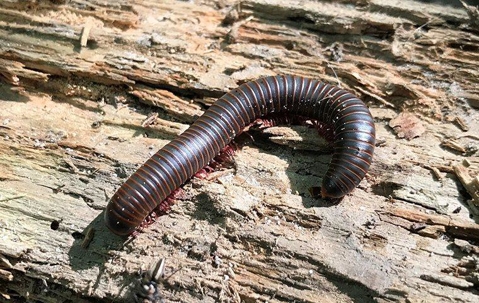Why Are There Millipedes Around My Boston Home?
Millipedes are long slender worm-like animals with four pairs of legs on most of their many segments. They are usually black or dark brown. They can grow to over an inch long. When threatened, they roll into a coil. Millipedes are generally just a nuisance, not a threat.
Medical Issues
Millipedes do not bite or sting humans. Some species do have glands on their legs that ooze hydrochloric acid when they are threatened. This acid will cause chemical burns on any flesh it touches. It can damage your eyes if you get it in them. It will also discolor the skin. It is best not to handle millipedes. If you do, be sure that you wash your hands with soap until there is no more millipede odor before touching any other part of your body, especially your face.
Lifecycle
Most millipedes are scavengers that eat decaying leaves and other vegetation. They overwinter in the soil. Ispring, they come out and lay 20-300 eggs in the soil, which hatch in several weeks. The young millipedes usually have only three pairs of legs and no more than seven segments. Each molt gives them more legs and more segments. In two to five years, depending on species, they reach sexual maturity. At that point, the females start laying eggs, and the cycle starts again.
In The House
If you find millipedes in your Boston home, they got there by accident. Millipedes cannot breed inside. In times of drought or floods, huge numbers may migrate to better quarters. During this migration is when most millipede infestations usually happen. If you crush them, it leaves a stain.
Prevention
Preventing millipedes is much like preventing any pest problem, and can be summarized as sanitation and exclusion. Millipedes can climb, so you have to make sure they can’t get in through wall cracks as well as foundation cracks.
- Seal all cracks in the foundation and outside walls with caulk.
- Make sure window screens do not have holes and fit tightly in the windowsill.
- Make sure the weather stripping under your doors is intact and has no holes.
- Seal openings in the wall around pipes, electrical wires, and cables.
- Move firewood away from the house.
- Clean up yard debris that might shelter millipedes.
- Cut back trees and shrubs that touch the house or hang over it.
DIY Millipede Treatments
Insecticides will not work on millipedes because they are not insects. They are more closely related to lobsters and shrimp than bugs. Because millipedes hide in such small cracks, it is difficult for pesticides to penetrate enough to kill them. Pesticides are also toxic, so they have to be used very carefully to avoid health problems for you, your family, and your pets. A millipede invasion is really not a DIY problem.
Get Professional Help
If you have a lot of millipedes, it is time to call in a professional. Urbanex can treat your house for millipedes. We have formulations that will work, even if there are lots of them.
When you contact Urbanex, we will send out a trained technician to inspect your property inside and out. After assessing the problem, we will give you a detailed plan of attack. If you agree, we will perform the initial treatment. In a month, we will return and treat the exterior again, just to keep more millipedes from getting in. After that, we will treat bi-monthly if you desire ongoing pest control. If you see any millipedes between treatments, which is rare, call and we will come right out and fix the problem. Contact Urbanex today and look forward to a millipede-free home.
Tags: home pest control | pest prevention | millipedes in boston |
Request Your Free Inspection
Complete the form below to schedule your no obligation inspection.

